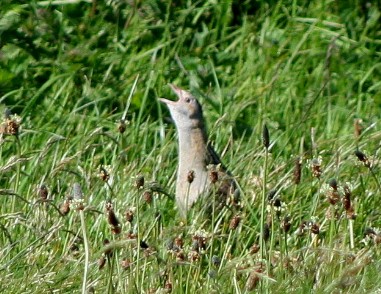Listen for Corncrake
Reports


There has been a report of Corncrake calling on Arran, the first report in twelve years. Corncrake is a summer visitor breeding in Europe and Asia from Ireland as far east as western China and migrates to Africa for the northern hemisphere's winter.
On Arran by the 1980s, Corncrake, this once familiar farmland bird with its distinctive rasping call, was in decline. The decline continued. In the 1980s Corncrake was reported each year except 1980. Often there was just a single bird calling but in 1983 three or four birds were reported. In the 1990s, there were reports of a single bird calling in 1990, 1993 and 1997. In the 2000s, again single records in 2005, 2006, 2007 and 2008. Interestingly the last three were all from the same location. The last report was one bird calling by Port na Lochan from 7 to 9 May 2008 and then silence…the bird had perhaps moved to its remaining heart lands in the Inner and Outer Hebrides.
This year on 13 May an email was received “This month in the early morning whilst I have been checking lambs between roughly five o’clock and seven o’clock I have heard a bird calling from a rashy field. I was not 100% sure that it was a Corncrake but after watching Landward a few minutes ago it definitely is.”
This is the time of year listen out for this summer visitor and early in the morning or late in the day are good times to do this. The systematic name for Corncrake is Crex crex , reflecting the male’s krek krek call. Click the image below to hear the call of the male Corncrake. The sound can carry a long distance. It is repetitive and unique.
Corncrake is mainly found in grassland used to produce hay, particularly moist traditional farmland with limited cutting or fertiliser use. Grassland which is not mown or grazed becomes too matted to be suitable for nesting, but crops such as cereals, clover or potatoes may be used. After breeding, adults move to taller vegetation such as reed, iris, or nettles to moult, returning to the hay and silage meadows for the second brood. Although males often sing in intensively managed grass or cereal crops, successful breeding is uncommon, and nests in the field margins or nearby fallow ground are more likely to succeed.
If you hear Corncrake calling on Arran, I would appreciate it if you would take a moment to let me know "where and when".